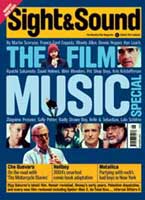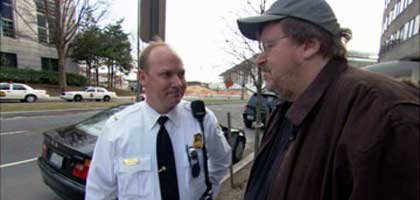
Fahrenheit 9/11
USA 2004

Reviewed by Mark Cousins
Synopsis
Our synopses give away the plot in full, including surprise twists.
A documentary about the business and political lives of George W. Bush and their relationship to the geo-politics of 11 September 2001 and to the class system in America. The film comprises 19 journalistic or satirical sections, ordered sequentially: (1) The Presidential election of 2000 and the media miscalling the result. (2) African-American members of Congress demanding a debate on the result but being refused because no senator would countersign their written requests. (3) The new President's slide in the ratings and his excessive holidaying in the eight months between inauguration and 9/11. (4) 9/11 itself. (5) Bush in Florida continuing with a photo opportunity despite being told of the second attack. (6) Despite all flights being grounded in the immediate wake of the attacks, Saudis, including the Bin Ladens, are allowed to fly from the US. (7) A long sequence on Bush's family and business relationships with key Saudi families, beginning with his friendship with James R. Bath, one of their advisors and investors. (8) Bush's immediate foreign policy response to 9/11 – asking advisors to find "an Iraqi hand" behind the attacks and bombing Afghanistan. (9) The installation of Hamid Karzai as president of Afghanistan and his approval of a pipeline to carry oil from the Caspian Sea. (10) Bush's domestic policy response to 9/11 – creating a climate of fear about terrorism. (11) The new USA Patriot Act and its use of the climate of fear to limit civil rights. (12) War in Iraq – aggressive tactics of US infantrymen, the suffering of and angry response from Iraqis. (13) The supporters of the war – the Coalition of the Willing and mainstream US media. (14) Military recruiting in economically disadvantaged places such as Flint, Michigan. (15) Bush's courting of the very rich and attempts to reduce soldiers' pay and benefits. (16) Flint resident Lila Lipscombe on the death of her son in Iraq. (17) How US businesses including Halliburton are benefiting from the war. (18) Moore asks members of Congress to sign their children up for the military. (19) The irony that poor people in the US are the first to support the system that maintains their poverty.
Review
Already the most commercially successful documentary ever made, Michael Moore's Fahrenheit 9/11 certainly plays well with audiences. Its mix of investigative journalism, agitprop, Saturday Night Live humour and tabloid signposting is, like Oliver Stone's JFK, a barrage of argument and impact. It rockets through the thicket of geo-politics, stopping for snapshots from this angle and that, leaving in its wake a bracingly kinetic portrait of an atavistic fool.
Since the film's central message, addressed to the American people, is that they are being lied to, it is reasonable to consider Fahrenheit 9/11's own veracity. Even on first viewing, it's clear there's room for concern. Moore uses evidence too casually and concludes too loosely. At one point (in the seventh of the film's 19 sections) he asks an interviewee to assess the degree of Saudi investment in the US. The unreliable answer is "I've heard figures as high as $860 billion" yet Moore takes this at face value and later asserts it – seven per cent of the US economy – as fact. Such weaknesses are emphasised by Moore's terrible interviewing style: rather than challenging an assertion he encourages it in a chummy way, or bumbles through, like Nick Broomfield but without the latter's fearlessness. Likewise, his otherwise revealing account of how six private jets and two dozen planes took Saudis out of the US after 9/11 when everyone else was grounded fails to be clear about why this is so concerning. At times even his satire is wanting. Moore's montage of countries that supported the Iraqi invasion (section 13) is snide and racist, effectively sneering 'look how trivial are the countries who support Bush', a position that simply undermines his argument.
Such mistakes are far outweighed by a remarkably patient approach to existing footage. Few documentary films use archive so rewardingly. The primary school sequence where Bush reads the children's book My Pet Goat after he hears that his country is under attack (section 5) is a real coup, the pay-off from looking at footage which has been used a thousand times before. Similarly Moore's simple montage of Congressional procedure blocking debate on Bush's election (section 2) is mature and moving. Of the newly shot material, it presumably took several crews many hours to capture the incident when American soldiers make fun of, and touch, a sleeping Iraqi's erection, but the fleeting moment speaks volumes.
These sequences indicate Moore's eye for the ironies of history and his brash poetics. His commentary is peppered with phrasing that owes nothing to the style of current-affairs newspeak. The first words of the film are "Was it all just a dream?"; he refers to "something called Fox News Channel"; he says that on 10 September 2001 Bush "went to sleep in a bed made of fine French linens"; he asks "Is it rude to suggest that when the Bush family wakes, it might be thinking of the Saudis rather than you or me?" His use of music is value-loaded too, of course, but he has the budget and the balls to play the Animals' 'We Gotta Get Out of This Place' as the Saudis flee in their private jets, and the Bloodhound Gang's lyric "burn motherfucker burn", as the rallying cry of GIs. The wide-eyed, straight-to-camera exuberance of the eager young soldier who describes this song is difficult to forget.
Some of Moore's best sequences are the more observational ones in Flint, Michigan and Washington with bereaved mother Lila Lipscombe (section 16). Though criticised by some, their slower pace and lack of commentary are both welcome, and the mainstream media's obedient downplaying of US casualties justifies their emotional inclusion. The sequences don't play to Moore's strengths, however; his real significance as a documentarist is the way his work is edited. Like Marcel Ophüls, he uses clips from film or TV to literalise or satirise a point: thus a moment of Dragnet finds its way into section 6, and after Bush uses the phrase "smoke 'em out" three times (section 8) we see a cowboy in some B-Western talking with the same swagger. When the President goes on television to announce the war in Iraq, Moore and his editors allow him three words "My fellow citizens" then cut to citizens, yes, but Iraqis, mostly children, playing on slides and among buildings. And the decision to portray 9/11 itself using only the sound of the planes (perhaps overdubbed with Dolby stereo effects) against 38 seconds of black screen, is a significant advance in how the event has been depicted cinematically.
Moore's claim at Cannes that he is merely Toto pulling the curtain back on the Wizard of Oz, revealing the crudity of his deceit, was funny but untrue. His sometimes tendentious film is a hypothesis about the iniquities of American power. A great work of editing and patience, it is marred by lapses in rigour. Despite this, Fahrenheit 9/11 ranks, as a work of cinema, with the best of Santiago Alvarez and Esfir Shub.
Credits
- Director
- Michael Moore
- Producers
- Jim Czarnecki
- Kathleen Glynn
- Michael Moore
- Screenplay
- Michael Moore
- Camera
- Mike Desjarlais
- Editors
- Kurt Engfehr
- Christopher Seward
- T. Woody Richman
- Music
- Jeff Gibbs
